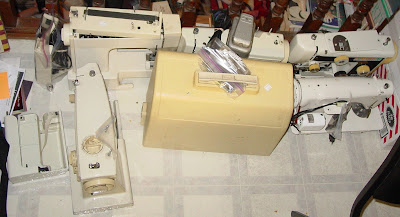Here are a few of my current projects. There are 4 Kenmores, a Riccar and one White (with "Janome" on it's cord).
If you can't tell, I have a thing for old Kenmores. These old Kenmores all have the oscillating hook system, and they were just made well. My Husband and I find these machines at the thrift store. They cost anywhere between $8 to $20. When I get them fixed-up, I can sell them for $50 to $100, and give someone a descent machine that will work well for a long time. And I get some great practice!
The Riccar is such a solid machine! It's only a straight/zig-zag, but was made when Riccar was Bernina. I was pretty excited about that one!
The White, my Husband got for the foot control, but I think it's probably worth fixing. We'll see...
What I look for when I buy a machine from the thrift store is #1 an oscillating hook system (it just makes the best quality stitch); #2 does it have it's hook, bobbincase and retention ring; #3 does it have the electrical in good condition. Sometimes I'll buy a junk machine just to get the foot control. You'd pay at least $30 for a new one, so paying $10-$15 for the whole machine is alright.
What to beware of? #1 a drop-in bobbin (I just don't like the stitch quality, and won't buy or sell them); #2 a needle bar that has forward/backward wiggle. It needs to wiggle side to side, but not forward and backward. If it wiggles forward/backward, you can't control the needle/hook distance, which is kind of an important timing setting; #3 an off-brand machine with missing parts; #4 has the machine been dropped; #5 are there any damaged gears?
My best find so far, was a Bernina 801 (minimatic) for $75, that I fixed-up and sold for $150.

This comment has been removed by a blog administrator.
ReplyDeleteyou said in this post needle shouldn't move forward and backward? i have a brother xr3774. the needle seemed needed to move back (away from me) because it would jab right into the bobbin race. i guessed the needle was supposed to be in the "gap" behind the bobbin race such that the hook could pick up the thread. but the needle not moving, the bobbin race was in the proper position (dots lined up) but it just not working. it would cost more to take it for repair than i paid for it. any advice would be helpful. thanks.
ReplyDeleteI posted a pdf on the front page of my blog. I hope it helps. http://shesasewingmachinemechanic.blogspot.com/ If not, I can get a picture of a machine at the shop.
DeleteYou say in this post that an oscillating hook provides a better stitch and that you also specifically avoid drop-in bobbin systems because they provide worse stitch quality. What specifically about the mechanics of these systems makes them create a better/worse stitch than the other? Thank you. :)
ReplyDeleteAs an oscillating hook comes to the bottom of the rotation, the thread passage opens to create a kind of zero gravity for the thread to pass through, as the take-up lever moves upward. When the thread passes over the top of the polished, metal bobbin case, it's a beautiful kind of smooth that no plastic bobbin basket can match.
DeleteWith drop-in bobbins, the thread drags all the way around the top of the plastic bobbin basket. If there is any texture on that plastic, the thread will catch on it and drag.
The thread kinda gets yanked through the thread passage on a drop-in plastic wonder. But only if there isn't any damage on the little plastic bump that slams against the spring at 600 slow, stitches per minute.
Also, I can't tell you how many plastic drop-in bobbin machines I've personally seen, that jam any time you try to sew anything thicker than 3 layers of cotton. They just do.
Some brands of machines with plastic drop-in bobbins will paint the tension spring shut, assuming that the owner of the machine will only be sewing with the thread and fabric that they used at the factory to set the tension. Wow! You no longer have control of the bobbin case tension.
When I sew Velcro with polyester thread, the tension will be different than if I'm piecing a quilt with cotton thread. ...or if I'm free-motion quilting. ... or sewing a chiffon fabric. If a person knows what good stitch quality is, they're comfortable with adjusting the tension for different applications. That's why they made the tensions adjustable in the first place.
That all makes a lot of sense given the context. I have never heard of or seen a painted-over tension spring before, but I'll definitely be keeping an eye open for that from now on!
ReplyDeleteThank you (again) for entertaining my curiosity and just in general sharing so much great information.